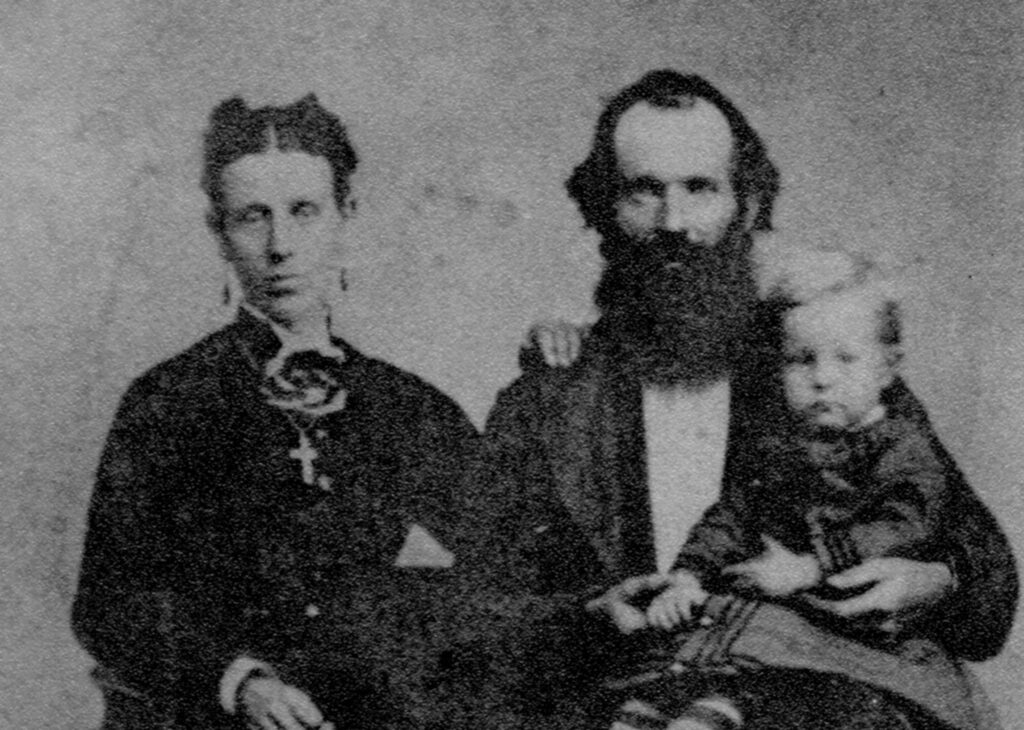Pat Benedict Jurgens and Mark A. Joyce, Co-authors
Colorado history was built on the larger-than-life men and women who came west to build new lives. The wagon drivers, farmers, miners, lumberjacks, mercantile owners, teachers, preachers, lawmen, and scoundrels who all formed the web that would become the 38th state. In Jefferson County the life of George Eugene Kerr is one such unsung story, beginning on a farm in Pennsylvania and ending under mysterious circumstances in Pueblo, Colorado.
Gold Fever
In the spring of 1860 George Kerr joined the thousands following the cry of “Pikes Peak or Bust” to search for gold. More than 11,000 wagons lined the trail west from Missouri to the Rocky Mountains, and the population of Central City burgeoned to 10,000 in a single month. Placer gold had been discovered in the foothills along Clear Creek, known as Gregory Gulch.
It was an exciting time for a young, unmarried man. George was a 27-year-old teacher and carpenter living in the Kansas Territory, which stretched into what is now Colorado. The oldest son of Mary and Joseph Kerr of Mercer County, Pennsylvania, George had left the farm at 17 to study and teach school in Holmes County, Ohio, for four years before moving further west. As great waves of immigrants poured across the plains, the spirit of adventure caught up with George, and he too headed for the Colorado front range, hoping for fame and fortune.
George tried his luck at prospecting, likely along Clear Creek near present day Idaho Springs. Perhaps he did not find enough gold to compensate for the primitive conditions amid the frenzy of thousands of hardscrabble miners. Or maybe he found just enough to give him a start. Many of the gold seekers stayed and settled the area. Golden and Denver were two towns that emerged as a result.
After a few months, he left the gold fields and found his way to Bergen Park, which Thomas Bergen described as “the most beautiful spot my eye ever rested upon.” With evergreen trees covering the landscape, he and a partner built a saw-mill on Bear Creek to process timber. Then George worked in merchandising, providing goods and supplies for the endless number of immigrants heading into the mountains. During this time, he built a log cabin in the area known as Creswell, a stage stop just a mile northwest of Bergen Park.
As more settlers moved in, a school was needed. Thomas Bergen, a leader of the growing community, engaged his son-in-law A. F. Post and George to construct it. Called “Bergen School,” it was the earliest school erected in the Conifer-Evergreen area and the only one for miles around. With his teaching experience, George became the first schoolmaster.
Family Life
About this time the family of Athey Miller, who had crossed the plains in a covered wagon, paused in their journey west for rest and paid work. They lived for a time near Myer’s Sawmill in present day Kittredge, and Athey would have attended Bergen School, which was about three miles up the Idaho Cutoff.
Athey’s sister Sarah Ann wrote in her memoirs about George, “During our sojourn in the mountains, sister Athey had become engaged to a young man of good reputation and fine character. He had a nice home and property. In October 1864, he claimed her as his wife, and took her back to his mountain home.” Her family went on to Washington territory while Athey stayed. She was 17 and George was 32 years old.
Arapahoe and Ute tribes were indigenous to the area; they were a part of life on the frontier. While not threatening, they could show up suddenly and silently at unexpected times. Athey’s sister told of the uneasy feelings she had when Arapahoes gathered around their wagon. It was prudent to have a supply of biscuits or bread to assuage hungry members of local tribes, and legend has it that Athey frequently gave them milk and cookies at her cabin.
It was not too long before George and Athey started a family. Mary Agnes came first, followed by Lottie Mae and Minnie Alice. Victor was born on the family ranch in Bear Creek Canyon in the 1870s. Mattie was born after they moved to property at the Morrison Hogback near Red Rocks. In 1890 they relocated to a house on the outskirts of Golden, so Mattie could attend high school there. Their house at 1020 19th St. is still standing today.
George’s younger brother Alex and family joined them in Colorado in 1874, also settling on a ranch along Bear Creek. He moved his family to Golden in 1886 (as George did in 1890) to enable his children to attend Golden schools. Alex was well-regarded as a prominent Grand Army man, Mason, sheriff and county commissioner.
Business and Community Leader
As the family grew, George became a substantial property owner in the area. In the early 1860s Colorado Territory was established and the Homestead Act passed, whereby a citizen could build a dwelling and work the land, claiming it free and clear after five years. George laid claim to hundreds of acres in what is now the El Pinal neighborhood near Bergen Park, land north of Morrison at the Hog Back, and other land east of Morrison. The home place property at Creswell he kept and later gave to his daughter Minnie.
In those days making a living in the mountains required juggling a variety of skills. George was a teacher, a farmer, and a miner. When they moved to Morrison in 1877, he ran a livery stable for several years. A brief biography of Minnie’s daughter Erma reads that grandfather Kerr “owned the clay pits between Golden and Morrison,” the site of the lime kilns that George supervised for some time.
George Kerr was an active and well-regarded leader in the mountain community along with his peers, Thomas Bergen and George Morrison. A Farmers’ Club was formed in Bergen Park with George as Corresponding Secretary. Residents met at the house of A.F. Post to form a group called Citizens of Bergen. George was Corresponding Secretary of this group as well. In 1874 George became one of the original trustees of the Bear Creek Wagon Trail with George Morrison and seven others, creating a company that built a toll road along Bear Creek between Morrison and Evergreen, that would eventually become Highway 74. He was also a founding member and trustee of St. Mark’s Parish. He was a representative from Morrison on the Republican Credentials Committee and a Trustee with George Morrison on the Morrison Stone, Lime, & Townsite Company. In addition, George was appointed an election judge for Bergen Park in1876. George E. Kerr became a pillar of the community.
The Mystery Begins: Disappearance
In the 1870s George’s name often appeared in the papers. In the next decade only two articles were published. Then his name disappeared from newspaper and historical records until 1891, when he was the Plaintiff in a suit in Weld County for money owed to him; however, he failed to appear in court. Three months later, the suit was refiled in the name of the “Estate of George E. Kerr.”
Two years after that, in The Colorado Transcript, June 14, 1893, George’s wife Athey and son-in-law R. L. Downes, as executors of his estate, published a notice to sell George’s properties totaling about 500 acres across multiple parcels.
Why was an estate created in George’s name while he was still alive, and why was his Estate selling his property?
The Plot Thickens: Mysterious Death
Five more years passed. In a February 9, 1898 hearing in Weld County, George E. Kerr was found “so distracted and disordered in his mind as to endanger his own person and the persons and property of others.” He was admitted to the Pueblo Insane Asylum the next day.
The mystery deepened when a Denver paper reported George E. Kerr’s death at the asylum on December 20, 1898. The family’s first inkling that George had died was when Alex saw the newspaper notice and contacted the institution in Pueblo for more information.
The cause of George’s demise was later documented by the institution’s druggist as Epileptic Mania. In the written record of his admittance “injury” and “epilepsy” were among the few legible words.
What happened to George? And why had no family member been notified when he died?
The Asylum Scandal
George’s death became entangled in a scandal that rocked the asylum in Pueblo. In late 1898 Dr. P.R. Thombs, who had been in charge for 20 years was under investigation by the state. He had responsibility for the care of more than 400 patients and was charged with insufficient oversight and gross neglect. Conditions were overcrowded; meals were sparse; outdoor exercise was almost non-existent; inmates were locked in their cells overnight. Cuffs and straitjackets were used for uncontrollable patients.
George Kerr’s death at the facility was reported like no other named patient. As recorded in the Colorado Transcript, February 1, 1899 – “Asylum Scandal – An Instance of the Gross Mismanagement of That Institution”:
The recent investigation of the administration of Dr. P.R. Thombs, superintendent of the insane asylum at Pueblo, brought out the fact that Geo. E. Kerr, formerly a well-known and respected resident of this county, had died there, although his relatives here had received no information on the subject. This is but one of many similar cases, all tending to prove Thombs’ palpable neglect and mismanagement.
This was widely reported as a stark example of the facility’s inept handling of patient deaths. The demise of George E. Kerr in the Pueblo Insane Asylum played a part in bringing to light the horrendous conditions at the institution, prompted the resignation of Dr. Thombs the Superintendent, and began a growing awareness for more humane treatment of mental health victims.
Lasting Impact
Five generations of Kerr descendants have lived in Colorado in the 162 years since George arrived in Bergen Park, and the family continues.
Of Athey and George’s children, Mary Agnes married and settled in Kelseyville, CA. Lottie Mae was a resident of Morrison and Evergreen for over 50 years. Victor graduated from the Colorado School of Mines and had a government job in the Philippines. Minnie lived a long, active life in Golden, becoming honorary president of the Pioneer Men and Women of Colorado. Mattie was valedictorian of her graduating class in 1900 and later became Post Mistress of Evergreen. Gary Kerr, Alex’s son, became a famous sheriff in Jefferson County in the 1920s and left his name on Kerr Gulch Road where he compassionately kept fugitives at his local jail.
The deeper questions about George’s injury and illness could only be answered by his family members who are long gone. A century ago, personal problems and difficulties were hushed. Mental health issues were taboo subjects. There was a silencing that surrounded any inexplicable behaviors that were an embarrassment. The answers are still hidden – with George’s wife Athey, his five children, brother Alex, and of course all the neighbors and friends who kept the secret of what happened to George Kerr.
George was a prominent homesteader with significant impact in the mountain community, on a par with Thomas Bergen and George Morrison. He was a community leader, schoolmaster, farmer/ rancher, sawmill owner, miner, businessman, judge, trustee, and substantial landowner. Unfortunately, his mysterious injury and illness led to an untimely demise.
George E. Kerr was a trailblazer. He deserves to be recognized and celebrated in Jefferson County history.
Sources
Our gratitude to George’s great-great grandson Tom McClintock and family who provided unpublished written materials and family photos collected and passed down through the generations, as well as original research that contributed to this article. Their inputs have provided valuable insights, to round out the picture of the man and his impact on the community.
Baker, Sarah Ann (Miller), The Memoirs of Sarah Ann Baker, unpublished memoir edited and prefaced by her daughter, Helen Baker Reynolds, dated circa 1938.
Colorado Historic Newspapers Collection. 1860-1898. Articles from the Colorado Weekly Chieftain, The Colorado Transcript, Golden Weekly Globe, The Greeley Tribune, The Jefferson County Republican, Morrison Monitor, Denver Evening Post, Jefferson County Graphic, The Daily Sentinel, Fort Collins Weekly Courier, West Mountain Tribune, and the Golden Transcript. https://www.coloradohistoricnewspapers.org/
Frazier, Ronda MS, CA, Archives Program Manager. Jefferson County Archives.
General Land Office Records from the US Department of the Interior, Bureau of Land Management. https://glorecords.blm.gov/search/default.aspx.
Hamilton, C. W. Our Memories of Bergen Park. Golden, Silver State Printers, circa 1958.
History of Clear Creek and Boulder Valleys, Colorado. Chicago, O.L. Baskin & Co., 1880.
Jacobs, Erma Violet Downes, unpublished autobiography, undated.
McGrath, Maria Davies. The Real Pioneers of Colorado. Denver, The Denver Museum, 1934.
Thomas Cunningham Bergen, https://morrisonhistory.org/people/thomas-c-bergen/, Morrison Historical Society, Morrison, undated.
PREVIOUSLY PUBLISHED IN HISTORICALLY JEFFCO MAGAZINE 2022


